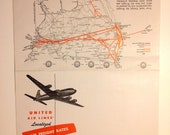

By the December 15, timetable, Continental was promoting service from Washington/Dulles to Houston (starting January 2, 1979). This meant Western had become a transcontinental carrier, offering direct (2 stop) service between the East Coast and Seattle.Īnother carrier to move with caution was Continental Airlines. had all been added from the airline’s traditional eastern terminus in Minneapolis/St. By the end of 1979, Milwaukee, Spokane and Washington D.C. While most carriers promoted the start of some new services by early 1979, Western took a more measured approach. So it should come as no surprise that the airline did not jump headlong into the uncharted waters of the deregulated environment. It was one of the few not to order the Boeing 747. They were the last of the trunks to introduce pure jet service in 1960, and also the last to offer widebody service, finally introducing the DC-10 in 1973.

Western Airlines was probably the most conservative trunk carrier in the country.

And many carriers had similar ideas for expansion, with Florida, Texas and Arizona being the most popular destinations for new service. Since these companies had fleets, employees and the required certifications, they would be the first to take advantage of the new opportunities.īut the approach taken by the airlines varied widely, from extremely conservative additions to wildly over-ambitious route expansions. The most immediate impact of the legislation was that the established airlines were able to take advantage of their new freedom to add routes, largely by applying for “dormant” routes, as well as one other route they could add each year without needing to receive CAB approval. Mergers would be approved at a much higher rate than in the past, which opened the door to carriers expanding through acquisition.New airlines could be formed to provide additional competition, and potentially lower the cost of air travel, thus bolstering the industry in general.Small carriers (primarily those seen as commuter airlines) would have the opportunity to operate larger aircraft, and potentially compete with the established carriers.Supplemental airlines could offer regularly scheduled services as opposed to only charters.



 0 kommentar(er)
0 kommentar(er)
